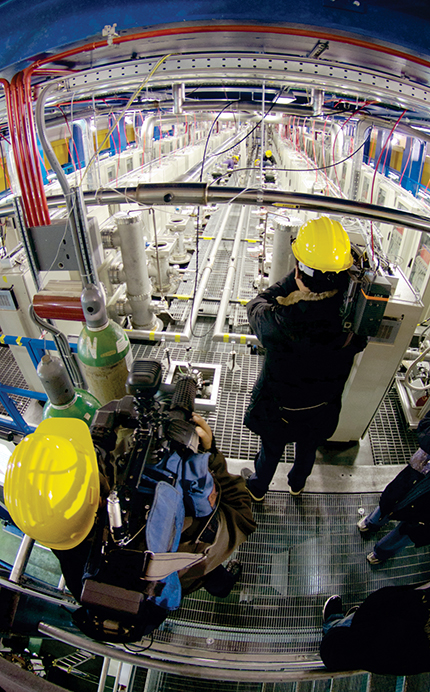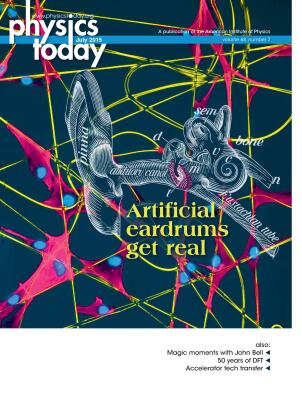Neutrino detector moves from Italy to Illinois
DOI: 10.1063/PT.3.2843
As a first stop in a journey from Italy’s Gran Sasso National Laboratory to Fermilab, the ICARUS detector is at CERN for an upgrade. Once it reaches its new home, the 760-ton detector will be used to determine whether sterile neutrinos exist. The relocation will also help strengthen the international collaboration needed to realize the US’s much larger neutrino ambition, a 40-kiloton detector in South Dakota’s Sanford Underground Research Facility.

Workers check out ICARUS’s cryogenics. Down the center of the 20-m-long detector is piping for the circulation and purification of 760 tons of liquid argon. The electronics racks along the sides contain nearly 53 000 readout channels.
INFN

The move dovetails with the particle-physics strategies on both sides of the Atlantic. In June 2014 CERN announced that, in focusing on the Large Hadron Collider and high-energy physics, it would mothball its neutrino beams. And in its most recent Particle Physics Project Prioritization Panel exercise, the US community put a world-leading program in neutrinos as a top aim (see Physics Today, July 2014, page 18
Running from 2010 to 2014 at Gran Sasso with a beam from CERN, ICARUS demonstrated that a liquid-argon time-projection chamber is an effective detector of neutrinos. Nobel laureate Carlo Rubbia, who had the idea for ICARUS and led the project, said in a 22 April statement that the method is expected to “become the leading technology for large liquid-argon detectors, with its ability to record ionizing tracks with millimeter precision.”
The ICARUS upgrade includes modern electronics, more photomultiplier tubes, improved cryogenics, and a veto system to reject cosmic rays. So far, CERN and Italy’s National Institute of Nuclear Physics (INFN) are putting about €10 million ($11 million) of hardware into the upgrade, but the total tab awaits the final design of the veto system—needed because, unlike at Gran Sasso, where about 1400 m of rock shielded the detector, at Fermilab ICARUS will sit just 10 m below ground. The INFN has invested roughly €40 million in ICARUS over its lifetime, not including salaries. The plan is to complete the upgrade and ship ICARUS in early 2017, with data-taking to begin in 2018.
Short-baseline trio
This month Fermilab begins excavating the dugout that will house ICARUS. Situated about 600 m from the lab’s neutrino source, the detector will be part of a trio of short-baseline liquid-argon time-projection experiments. The 170-ton MicroBoone, located 470 m from the source, will start later this year trying to untangle anomalies of Fermilab’s earlier MiniBoone experiment (see Physics Today, October 2010, page 14
The ICARUS detector will look for sterile neutrinos, which are hard to pin down because—if they exist—they don’t interact with matter. Over the past 15 years, says INFN vice president Antonio Masiero, “various experiments have had results that could not be accounted for by the presence of only three neutrino species. This is quite a puzzling thing.”
Measurements of the neutrino flavor distribution at the SBND will be used to predict the beam makeup at ICARUS. Either more electron neutrinos or fewer muon neutrinos than expected would point to new physics, says Peter Wilson, coordinator of Fermilab’s short-baseline neutrino program. “One would then need to interpret the result to determine if this is a sterile neutrino or some other new physics.” The key is ICARUS’s large volume. Says Fermilab director Nigel Lockyer, “It’s supposed to be an experiment to either find or rule out sterile neutrinos at the 5-sigma level. That’s the gold standard now.”
The anticipated 40-kiloton detector, previously known as the Long Baseline Neutrino Experiment, was renamed the Deep Underground Neutrino Experiment (DUNE) earlier this year when international partners joined. Located some 1300 km from Fermilab’s neutrino source, DUNE will be used to study flavor oscillations. “It’s going to be 7 to 10 years before science comes out of DUNE,” says Wilson. “The short-baseline experiments provide an opportunity for people to do science on shorter time scales and to develop students and junior scientists. ICARUS and the other short-baseline experiments will give input for understanding observations at DUNE.”
Scientists from about 40 institutions in the US and Europe are involved in Fermilab’s short-baseline neutrino program. Says Wilson, “Everyone who is working on this is [also] aiming to do physics with DUNE.” So far, the DUNE collaboration involves about 750 scientists from 145 institutions in 23 countries.
More about the Authors
Toni Feder. tfeder@aip.org
